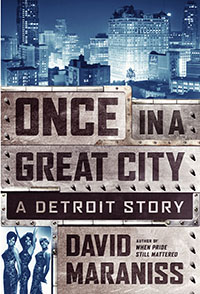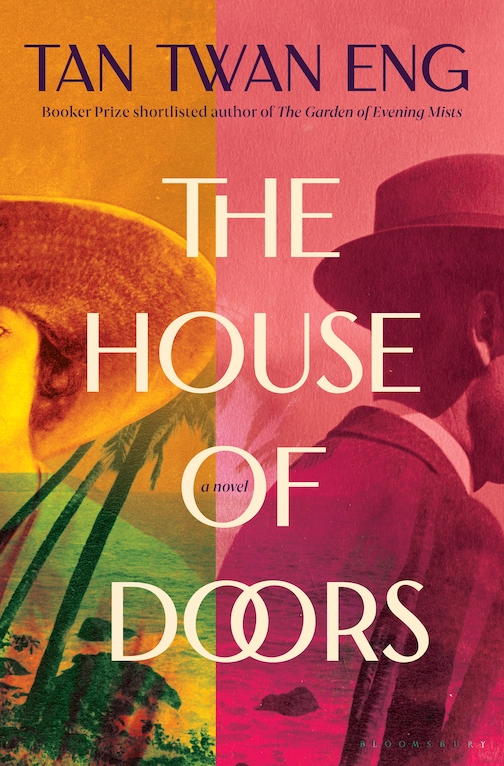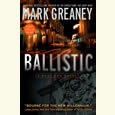Glowing with Promise, Rotting from Within
David Maraniss chronicles eighteen months in the history of Detroit, when the city was at its peak
The Ford Rotunda rose ten stories high, a massive circular structure with grooved walls, gleaming like a futuristic birthday cake. Originally designed for the 1934 World’s Fair, it was then moved to Dearborn, Michigan, on the southwest edge of Detroit. It became one of the nation’s top tourist attractions—more popular, for a time, than the Washington Monument or the Statue of Liberty. Constructed from steel and limestone and topped by a geodesic dome, it showcased exhibits that celebrated Ford cars and American power. But in November of 1962, a fire spread through the magnificent edifice. It buckled under, leaving smoke and dust and ruin.
 So begins Once in a Great City: A Detroit Story, the latest gem of narrative history by David Maraniss. A prolific author of impressive books on the recent American past, Maraniss now offers this saga of Detroit from the fall of 1962 through the spring of 1964. It was a time when the city exemplified the best possibilities of post-war America: industrial power that mutually benefited management and labor, liberal government that enriched civic life, and African American advancements that fostered racial harmony. But like the Ford Rotunda, it would all come crashing down.
So begins Once in a Great City: A Detroit Story, the latest gem of narrative history by David Maraniss. A prolific author of impressive books on the recent American past, Maraniss now offers this saga of Detroit from the fall of 1962 through the spring of 1964. It was a time when the city exemplified the best possibilities of post-war America: industrial power that mutually benefited management and labor, liberal government that enriched civic life, and African American advancements that fostered racial harmony. But like the Ford Rotunda, it would all come crashing down.
Maraniss’s story revolves around compelling personalities, including two giants of the auto industry, Henry Ford II and Walter Reuther. Ford resisted his own company’s hidebound corporate culture, often escaping Detroit to visit his mistress in Italy. “He had some traits of his grandfather, especially a killer-cold ability to fire people without compunction,” writes Maraniss, “yet there was enough of the irrepressible rogue in him to make him compelling, if never endearing.” Reuther, president of the United Auto Workers, envisioned organized labor as the engine for a better America. While improving the pay and conditions for his workers, he was immersing himself in the civil-rights movement and speaking at the March on Washington.
Among Reuther’s ideas was the “all-American small car,” a cooperative venture among labor unions and Ford, Chrysler, and General Motors. The “Big Three” automakers balked—Reuther’s idea bucked the basic tenets of the industry. Seeing a more conventional road to prosperity, Ford touted the growing pool of car buyers, including women, youth, and foreign markets. In 1964 he unveiled the Mustang, a signature car that oozed muscle and sex.
Pragmatic, can-do liberals guided Detroit. Democratic mayor Jerome Cavanagh cast himself in the mold of John F. Kennedy—a handsome Irish Catholic from a big family, full of practical ideas on how to improve the city. Governor George Romney, former president of American Motors Corporation, was a liberal standard-bearer for the Republican Party and a possible future candidate for the U.S. presidency. Cavanagh and Romney were part of the delegation that pitched Detroit as host of the 1968 Summer Olympics, a promising bid that ultimately failed.
 A glow of promise also colored the rise of Motown, a musical empire that emerged from a two-story house on West Grand Boulevard. The entrepreneurial Berry Gordy sent his performers on the road, spreading a gospel of finely tailored, soul-inflected black music for crossover audiences. The talent was mind-boggling: Mary Wells, with her chart-topper “My Guy”; musical geniuses such as Smokey Robinson, Marvin Gaye, Little Stevie Wonder, Martha Reeves and the Vandellas, the Marvelettes, the Contours, Singin’ Sammy Ward. The first hits for the Supremes, the Temptations, and the Four Tops were still to come. Maraniss calls this tour the essence of Gordy’s business model: “the complete sales package, all things Motown, vertical and horizontal, everything and everyone together, imported from Detroit, all in the family.”
A glow of promise also colored the rise of Motown, a musical empire that emerged from a two-story house on West Grand Boulevard. The entrepreneurial Berry Gordy sent his performers on the road, spreading a gospel of finely tailored, soul-inflected black music for crossover audiences. The talent was mind-boggling: Mary Wells, with her chart-topper “My Guy”; musical geniuses such as Smokey Robinson, Marvin Gaye, Little Stevie Wonder, Martha Reeves and the Vandellas, the Marvelettes, the Contours, Singin’ Sammy Ward. The first hits for the Supremes, the Temptations, and the Four Tops were still to come. Maraniss calls this tour the essence of Gordy’s business model: “the complete sales package, all things Motown, vertical and horizontal, everything and everyone together, imported from Detroit, all in the family.”
Beyond music, Detroit captured all the glories and tensions of the civil-rights movement, which spread beyond the South. The charismatic minister C.L. Franklin—father of Aretha Franklin—organized the 1963 Walk to Freedom, the largest black political demonstration in American history to that time. It was here that Martin Luther King gave a version of his “I Have a Dream” speech, which he later refined for the March on Washington. Later that same year, also in Detroit, Malcolm X gave his landmark “Message to the Grassroots,” which critiqued the basic tenets of the civil-rights movement. He tapped into black Detroit’s roiling frustration, stirred most recently by a white policeman’s shooting of a prostitute named Cynthia Scott.
Maraniss deftly weaves these narratives together, but he also helps explain how Detroit became the case study for how cities fail. A 1963 study by sociologists at Wayne State University described how wealthy whites were fleeing to the suburbs, rendering the city’s population increasingly black and poor. “The report predicted a dire future long before it became popular to attribute Detroit’s fall to a grab bag of Rust Belt infirmities, from high labor costs to harsh weather, and before the city staggered from more blows of municipal corruption and incompetence,” writes Maraniss. “Before any of that, the forces of deterioration were already set in motion.”
By the 1970s, the auto industry was in decline, organized labor was losing influence, the political careers of Cavanagh and Romney had derailed, Motown had decamped for California, and Detroit was scarred by a massive 1967 race riot. Once in a Great City paints the moment before the fall with dabs of lush historical detail, rescuing the vibrancy of a once-great American city.

Aram Goudsouzian chairs the history department at the University of Memphis. His most recent book is Down to the Crossroads: Civil Rights, Black Power, and the Meredith March Against Fear.


